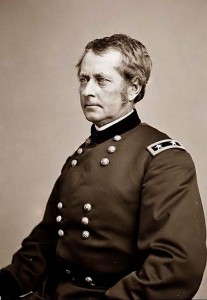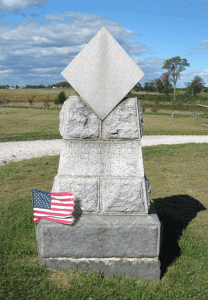Daniel E. Sickles, Continued
This article is a continuation of my series on Union Major General Daniel E. Sickles during the Civil War. The first post can be read here.
So how did Dan Sickles end up in command of 10,000 troops at Gettysburg? Politics, that’s how.
For as much as we like to lionize Abraham Lincoln these days, we have to remember that he was a politician – and a damn good one. The Civil War was not popular among the opposition Democrats, who went so far as to describe the war as a purely political one against the south being played out by Lincoln. To them, this was “Mr. Lincoln’s Little War”.
Lincoln was a Republican President who needed the support of Democrats in Congress to continue the war. Sickles was a disgraced Democratic politician who needed to restore honor to his image. The result was inevitable. When Sickles became heavily involved in successful recruiting efforts in New York, Lincoln rewarded him with a commission as a Brigadier General.
As a result of more political maneuvering within the Army, Sickles eventually rose to the rank of Major General, and was given command of the 3rd Corps before the Battle of Chancellorsville, befriending fellow Generals Dan Butterfield and Joe Hooker (who was in command of the Army of the Potomac for the Battle of Chancellorsville) along the way. These three were kind of the frat boys of the Union Army.

At Chancellorsville, Sickles was ordered off of the best piece of ground for artillery on the field: Hazel Grove. Almost as soon as his troops left, the Confederates set up their own artillery and pounded the nearby Union line, forcing Hooker’s withdrawal.
Two months later, at Gettysburg, the memory of that last battle was fresh in Sickles’ mind. He entered the field at Gettysburg on the evening of July 1, 1863 by way of the Emmitsburg Road, next to a peach orchard that, like Hazel Grove, seemed like a great place for artillery.
By morning, Sickles was unhappy. He had been placed on the left side of the Union line, along the low rise of Cemetery Ridge. In front of him was a rocky, marshy, ugly piece of ground and a line of trees that obscured the view of his front and made artillery placement impossible. He found himself yearning to be in that peach orchard from last night. Eventually, he made his way up to Army headquarters where General Meade was much more concerned about the possibility of an attack from the right than he was about Sickles’ nonsense.
After a few unsuccessful lobbying attempts that morning, Sickles finally convinced Meade to send someone down to look over the 3rd Corps’ position with him. General Henry Hunt, who literally wrote the book on artillery prior to the war, accompanied Sickles to the southern end of the field to help him place his guns. It was clear that the position was horrible for artillery. When Sickles showed General Hunt his preferred location at the Peach Orchard, Hunt agreed that it would be more suitable, but reminded Sickles that he wasn’t authorized to order the move. Even if he were, Hunt said, it would be a good idea to scout out the woods nearby to make sure that there was no enemy force in there.
Sickles took the suggestion and sent a party of sharpshooters and a couple regiments of troops into those woods. Within minutes, they were skirmishing with hidden Confederate troops massing for an attack. Sickles felt that he had no choice – he had to move his line to the Peach Orchard – even without permission.
Sickles didn’t really care about getting Meade’s permission anyway. He didn’t like Meade: the stuffy, Old-Army officer who less than a week before had replaced his pal Hooker in command of the Army. Meade didn’t have a whole lot of respect for Sickles, either. Regular Army officers tended not to like non-professionals who were promoted into command positions with little or no training – especially when they were politicians.
From Army headquarters, Meade could see the 3rd Corps line breaking off and moving out to the exposed position at the Peach Orchard and along the Emmitsburg Road – a line nearly twice as long as they had been assigned to hold. He immediately sent to Sickles for an explanation, but heard nothing back. Meade had to go see for himself, but by the time he arrived, Sickles’ men were being attacked and it was too late to pull back. Meade sent for all available reinforcements to aid General Sickles.
The famous Peach Orchard, while good for artillery, did not prove to be very defensible, and it wasn’t long before it was being attacked from two sides. The position crumbled shortly thereafter.

Sickles could see all of this happening from his headquarters at the nearby Trostle Farm. As he was mounted on his horse, watching the collapse of his line, he felt something wet on his pant leg and, bending down to investigate, realized that a Confederate artillery round had flown right along-side his horse and smashed into his leg, leaving his shin bone shattered and this leg dangling lifelessly.
Some stories have him calmly requesting a stretcher and “cooly” smoking a cigar as he is carried to the rear. That’s a romantic legend that didn’t happen, though. Immediately after the wounding, Sickles was in hysterics – pleading with the officers on his staff not to leave him to be captured. He was successfully evacuated to a field hospital behind the 3rd Corps line, somewhere along the Taneytown Road. Once he was stable, he was transported to the Daniel Schaefer Farm on the Baltimore Pike to recuperate further. It was at one of these field hospitals that his right leg was amputated at the knee.
Most limbs amputated during the Civil War were simply discarded. There were piles of arms and legs outside of every field hospital. Medical techniques and training were also not very advanced. Most doctors during the Civil War had never seen the inside of a human body – operating on cadavers (even for training purposes) was illegal in most states. Since the skills and experience of the medical department was not up to snuff, the Army Medical Corps had put the word out by 1863 for people to come up with training materials and documentation on wounds and treatments.
Sickles knew about the training initiative. He used his political influence to have his newly-amputated leg saved and turned over to the Army Medical service, and it was placed (at his request) in the Army Medical Museum where you can still go visit it today (as Sickles himself did regularly for the rest of his life).

When he was well enough to be moved a greater distance, he got on the road to Washington, DC where there were larger established hospitals and politicians that Sickles could chat up about what REALLY happened in the late battle. Sickles claimed that if it weren’t for him, Meade would have retreated from Gettysburg to his preferred Pipe Creek Line, leaving the field to the Confederates who would have rightly claimed victory. He made enough noise (combined with the fact that the Confederate Army escaped relatively unharmed across the Potomac 10 days after Gettysburg) that it tarnished Meade’s reputation and led to hearings by the Committee on the Conduct of the War investigating Sickles’ accusations and Meade’s supposed lack of action.
We still argue about whether Sickles really deserves that “hero of the battle” title today. While his actions did spoil the element of surprise in the main Confederate attack on July 2, that attack was not very well executed itself, and probably only did as well as it did because the 3rd Corps was in an exposed position. Sickles hardly planned his own actions that day, too. His beef with Meade was not a disagreement about tactics or strategy, it was personal. Sickles purely wanted his old pal Hooker back in charge and used the best tool he knew in his attempt: politics.
While the battle itself was finished, Sickles’ impact on Gettysburg wasn’t over yet. But we’ll cover that in the final post….
Also – If you’re interested in learning more about Dan Sickles, may I suggest James Hessler’s outstanding book, Sickles at Gettysburg? While it focuses specifically on his involvement with Gettysburg (both during and after the war) it gives a good overview of his life in the process.